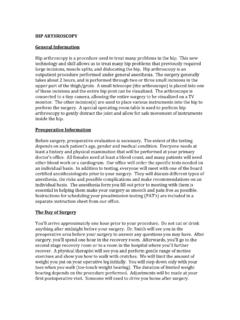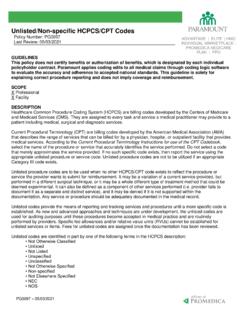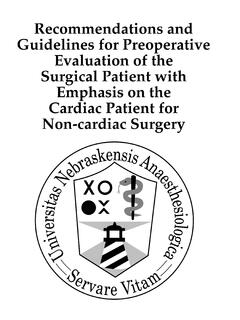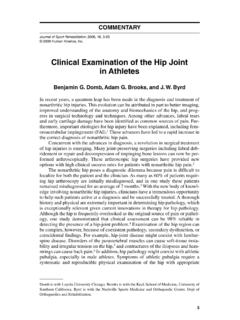Transcription of Hip arthroscopy – Frequently Asked Questions
1 Hip arthroscopy Frequently Asked QuestionsWhat is a hip arthroscopy ?Hip arthroscopy is key hole surgery. Usually 2-3 small incisions (about 1 cm long) are made on the side of your hip. Through these holes, special cameras and instruments are used to look around your hip and do your is the hip joint?The hip joint is a ball and socket joint made up of 2 bones. The ball is the head of the femur (part of your thigh bone) and the socket is the acetabulum (part of your pelvis)The hip joint is lined by special glistening tissue called articular cartilage which provides a smooth lubricated surface for your hip joint to move freely without pain or the rim of your acetabulum (the socket), is a special type of cartilage called your labrum. It acts to effectively deepen your socket, providing more stability to your is femoroacetabular impingement?Femoroacetabular impingement is a term used when the bones of you hip joint are not shaped properly.
2 There are 2 types of impingement. CAM impingement occurs when your ball (femoral head) is not perfectly round, often described as having a bone spur or bump. Pincer Impingement occurs when your socket (acetabulum) is too deep, directed the wrong way or has excess bone around the you move in certain directions, the bones grind on each other abnormally. This leads to tearing of your labrum and is also one of the factors that scientist believe lead to common is femoroacetabular impingement?1 in 4 people have this condition. But not everyone who has femoroacetabular impingment will develop hip OPERATIONHow is a hip arthroscopy performed?After you are asleep, your foot is placed into a padded boot. A traction device is then used to pull on your leg, so that the hip joint opens up. With the help of an Xray machine, the exact location of your hip joint is found and the surgical instruments are long does the procedure take?
3 Usually between 1 hours, depending on what needs to be type of anaesthetic will I have?You will have a general anaesthetic. This involves having medication which is given through an IV cannula (usually in the forearm or hand). This medication makes you go many sutures will I have?Each small hole is closed with 1-2 sutures. Surgical tape and dressings are then placed over these are the potential risks and complications of having a hip arthroscopy ?Problems following hip arthroscopy are rare. However, you should always consider the risks before having any type potential risks from Hip arthroscopy include: Risks associated with having a general anaesthetic Infection. The chance of having an infection is about 1:5000. This ranges from a simple skin infection that is easily treated with antibiotics to a serious complication called a deep joint infection. This needs to be treated with intravenous antibiotics and further surgery to clean the joint.
4 Nerve numbness (paraesthesia). Sometimes the traction used during the operation can cause pressure on the nerves in the groin and lead to temporary numbness around the groin and genitalia. This is very uncommon, and should resolve over a few days. There are many other theoretical risks including fracture, avascular necrosis and impotence, and they are extremely rare and we have never seen them surgery carries some risks. All efforts are made to minimise these risks. Please feel free to discuss potential problems with Mr O THE OPERATIONHow long do I stay in hospital?Most people stay in Hospital for one night, and go home next morning. Some choose to go home on the same day as the happens after my operation?You will be taken to the recovery room, where a nurse will look after you until the anaesthetic has worn off. Then you will taken to your ward, where your friends and family can visit painful is the procedure?
5 Most patients report that the pain is much less than they expected. During the operation, local anaesthetics are given before and after the procedure. Because the operation is key hole surgery, the pain is much less than traditional open the operation, your nurses will give you different types of pain relieving medications to help with any pain or discomfort. Will I have bruising or swelling?There is usually some swelling around the groin, thigh and buttock regions which goes away over a few days. Very occasionally, if your procedure is particularly large, then you may have some bruising around your groin that tracks down towards your knee. Don t be too worried about this, it s the natural effect of gravity and the bruising will disappear gradually over a couple of I need crutches?It is completely safe to walk without crutches, but using crutches for at least a couple of days is very useful as it helps with any discomfort.
6 The general rule is, if you are limping due to discomfort, you should be using crutches. How do I look after my wound?The day after the operation, the bulky dressings are removed. This leaves you with waterproof dressings, which should all be removed 4 days after your surgery, leaving only your sutures. The sutures will be removed by Mr O Donnell, 1 week after the is important to watch for any signs of infection around your wound, such as increasing pain, redness or swelling. If you are concerned, please ring Mr O Donnell or your will I see Mr O Donnell again?About 1 week after the surgery. Your stitches will be removed and all the findings of your operation will be explained to you. Depending on your speed of recovery, you may need a second appointment about 6 weeks I need to do physiotherapy?Physiotherapy is not essential to your recovery but is very useful to have before and after your it involves 1 appointment before the operation and 3 appointments physiotherapy starts 1 week after your operation and is individually tailored towards your needs.
7 Your physiotherapist will develop a strength and rehabilitation program for you and guide you with your return to sport and long will it take me to recover after a hip arthroscopy ?The recovery after hip arthroscopy can be variable and depends on your symptoms before the operation and the surgical is a general guide to time frame WalkingImmediately after the operationPain free walking2 - 6 weeksRunning4 - 6weeksCompetitive sports8 - 12 weeksAre there any tips from other patients? Sleeping. Sleeping can be difficult on the side of your operation. If possible, sleep on your back. Or, sleep on your non-operated side with a pillow between your legs. Prepare your home. Try to organise you home so that things are easy to get to. You will have discomfort, especially when bending over, so make things easy for yourself. Look after yourself. Having an operation should be considered a big thing. So take some time to really look after yourself and don t rush around trying to multitask.
8 You should be recovering, not working. Toilet seats. Going to the toilet can be uncomfortable. A raised toilet seat can help Sitting. Sitting with your hips at 90 degrees can be painful. Try to lean back and sit with your hips less bent. In the car. Wind back your car seat Bending over. Try not to bend over too often. Get someone to help you with your shoes and socks Have someone look after you. Normal activities such as showering, toileting, putting on shoes and socks, getting in and out of chairs, getting in and out of bed can be difficult in the first few much time should I take off work?It depends on your job and what procedure you had done. Generally, taking at least 1 week off work is recommended. How long until I can drive?You can drive once your hip discomfort does not impede your driving ability and you feel confident to do so. As a general rule, it is safe to drive when you are no longer using your crutches and are walking you drive a manual car and you ve had a left hip arthroscopy , avoid driving for 2 weeks as it will flare up your there any reliable internet sites I can look at?
9 Mr O Donnell s and Mr Pritchard s website about hip Easy to understand information about Orthopaedic Surgery from the staff at Western Patient information for the American Academy of Orthopaedic Surgeons







![Rapport de Stage[1] - AMHE](/cache/preview/f/2/d/8/6/c/c/4/thumb-f2d86cc468ddd8cce0b10199ae834215.jpg)

